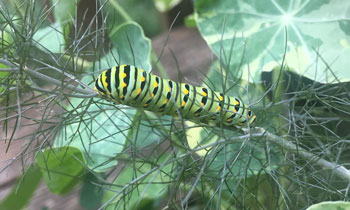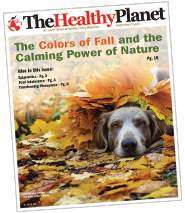
By Linda Wiggen Kraft,
Healthy Planet Green & Growing Editor
In this dreaming part of the year as we prepare for the upcoming garden season, think of your garden in perhaps a different way. A way of gardening where we realize that we are guardians not just gardeners. We are here to care for the sanctuary of land and all the life upon it that we call our gardens. Our gardens are not for our pleasure alone.
Our vision should be like the Native American principle of Seven Generations where decisions today result in a sustainable world for seven generations in the future. We need to realize our gardens are arks. Not just something beautiful to look at, but lifeboats to save the lives of insects, birds, toads, frogs and many other creatures who need our help in surviving. And we in turn need these creatures for our lives.
How to go about creating guardian gardens that can be seen as arks? Look to many resources available online and in local groups. A national effort is Home Grown National Park, (https://homegrownnationalpark.org). Its goal is for homeowners and landowners to create enough habitats that support insects and wildlife with native plants that together will be more land than all the national parks. Started by Doug Tallamay, who is the best-known scientist studying the relationship between insects and native plants. He strongly suggests planting not only native plants, but keystone native plants as well. Keystone plants are 14% of native plants that support 90% of butterfly and moth life.
Books by Doug Tallamay give in depth information about how necessary and important our gardens are to provide habitat for all. Bringing Nature Home – Updated and Expanded: How You Can Sustain Wildlife with Native Plants, and Nature’s Best Hope – A New Approach to Conservation That Starts in Your Yard are two inspiring books that share great information about how to create a garden ark.
We are the ARK is a complementary vision to Home Grown National Park. Based in the UK by Mary Reynolds, who wrote We Are the ARK: Returning Our Gardens to Their True Nature Through Acts of Restorative Kindness and The Garden Awakening: Designs to Nurture Our Land and Ourselves. Mary defines herself as a reformed garden designer who calls for gardens and lands to sustain wildlife as arks in protecting and sustaining life. The website (https://wearetheark.org/) provides step-by-step information of what can be done. The emphasis is on native plants for whatever region the garden is growing in. There is also a map of ARK landscapes throughout the world. It shows five in the St. Louis region.
For more local information Saint Louis Audubon Society and Wild Ones St. Louis Chapter have great information and help. Saint Louis Audubon has Bring Nature Home, A Nature Inspiration and Consultation Service, (https://stlouisaudubon.org/bch/). A consultation is available, although there is a waiting list, to help your garden become a habitat for birds and wildlife. The website has lots of information and links about what to plant and how to set up a garden habitat.
Wild Ones St. Louis Chapter promotes creating native landscapes. It is the largest of all the Wild Ones chapters in the U.S. Its primary goal is to educate and support homeowners as they learn and develop their own native landscapes. There are monthly gatherings, grants for schools & non-profits and information shared by members of Wild Ones. Check out all they offer at (https://stlwildones.org/)
This year create an ark for plants and animals in your garden. It will be more than just beautiful for you and all that live there.
Linda Wiggen Kraft is a landscape designer of holistic/organic gardens. She is an artist and creativity workshop leader also. Her ceramic jewelry and pottery are available online. Check her website for details. Find out more, subscribe to her blog and Instagram at www.CreativityForTheSoul.com, Call her at 314 504-4266.


